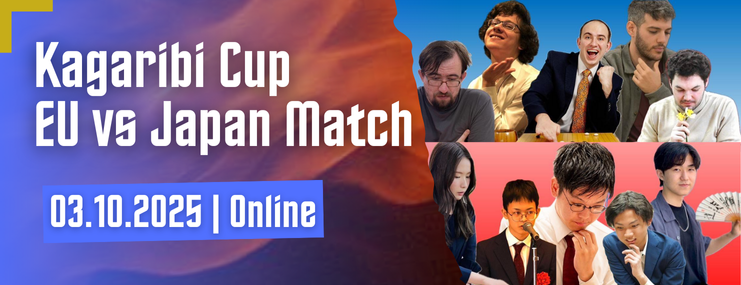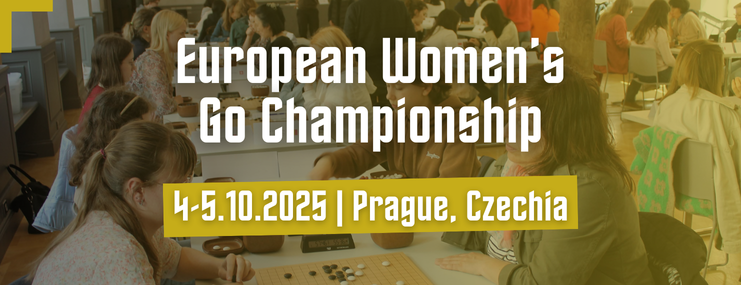Dia. 1. A fragment from the game
This board position is taken from my game against Pal Balogh 7d (Black) played online on the 27th of February in round 6 of the Pandanet European Team Championship.
Black 2 was a pincer rarely seen in professional games nowadays. I remember this joseki from the pre-AI era and responded accordingly. After the game, I decided to take a look at it with the AI. Below, I share my KataGo research with approximately 100,000 playouts for each move.
Dia. 2. San-san invasion
I didn’t want to play a san-san invasion because I thought it best not to give Black additional influence, considering his walls in the upper part of the board, but KataGo actually doesn’t see anything wrong with this idea – White’s winning percentage even rises by 3% compared to the actual game.
After Black 10, the AI suggests that White play around A to reduce the large black moyo.
Dia. 3. Double kakari
A double kakari at White 1 is playable too, according to KataGo. It’s approximately as effective as the san-san invasion in the previous diagram.
White takes the corner while Black gains more influence. The proverb says, “Resign if you have lost four corners,” but this is not the case – it’s an even game.
Dia. 4. Spectacular attachment
KataGo claims that the spectacular attachment at 1 is slightly better than White 5 in Dia. 1 – White’s winning probability is 1% higher here.
Black 2 is one possible follow-up. We will investigate alternatives below.
Black 6 is another shape that would be hard to come up with for a human player. After White 9, Black can continue fighting at A or extend on the lower side at B.
Dia. 5. Hane from the other side
Black 1 is a playable response, too. After White’s crosscut, Black sacrifices a stone on the right side to gain thickness and enclose the corner.
After Black 11, White can play a big local move at A or extend on the lower side at B – both moves are equally good.
Dia. 6. Complicated fight
White 1 instead of a crosscut at 2 in the previous diagram is a playable alternative that leads to a complicated fight.
White makes a ponnuki in Black’s lower-right corner, which looks great, but Black captures the two stones on the right side, complementing the influence above. According to KataGo, this is also an even game.
Dia. 7. Extension to the third line
Black might also choose to extend to the third line – an equally effective alternative to Black 2 in Dia. 4 and Black 1 in Dia. 5.
Black 5 and 7 sacrifices the two stones on the right side and KataGo suggests playing a big move elsewhere after this, for example at A.
Black doesn’t play the tempting atari at B because it can serve as a ko threat later.
Dia. 8. Empty triangle
Black 1 and 3 after White 4 in the previous diagram create an empty triangle – a shape considered generally bad. Sometimes it doesn’t matter if the shape is good or bad, but in this case the AI recommends avoiding this shape – this sequence lowers Black’s winning percentage by 5%.
White 6 is an elegant and good-looking shape that reduces Black’s influence above while capturing the cutting stone. White can still invade the corner at A in the future.
Dia. 9. Extension towards the center
After White’s attachment, Black 1 – an extension towards the center – drops Black’s winning probability by 4%. After White 2, Black has to cut at 3 and White 4 – 12 captures the two stones on the right side.
After Black 13, White A is a big move, but White can wait to play it at a later stage of the game.
Dia. 10. Improvement for Black
Black 6 in Dia. 1 was a slightly slack move. Black 1 in this diagram improves the winning percentage by 5%.
After Black 9, KataGo would play A to reduce Black’s influence in the middle. This move also aims at the cutting point at B – it’s a ladder-breaker.
Dia. 11. Alternative for White
Instead of White 4 in the previous diagram, White may also choose to play as shown here.
After White 13, Black can enclose the corner by playing A or occupy a big point elsewhere, for example B.
In this case, White creates a thick shape that reduces Black’s influence while Black makes points.
Dia. 12. Old joseki
According to KataGo, the connection at 1 instead of Black 3 in Dia. 10 is a mistake. The sequence up to White 8 is an old joseki but according to the AI Black drops around 10% in winning probability compared to Dia. 10.
I hope you enjoyed this brief research and that it helped you develop your understanding of the game!









.png)